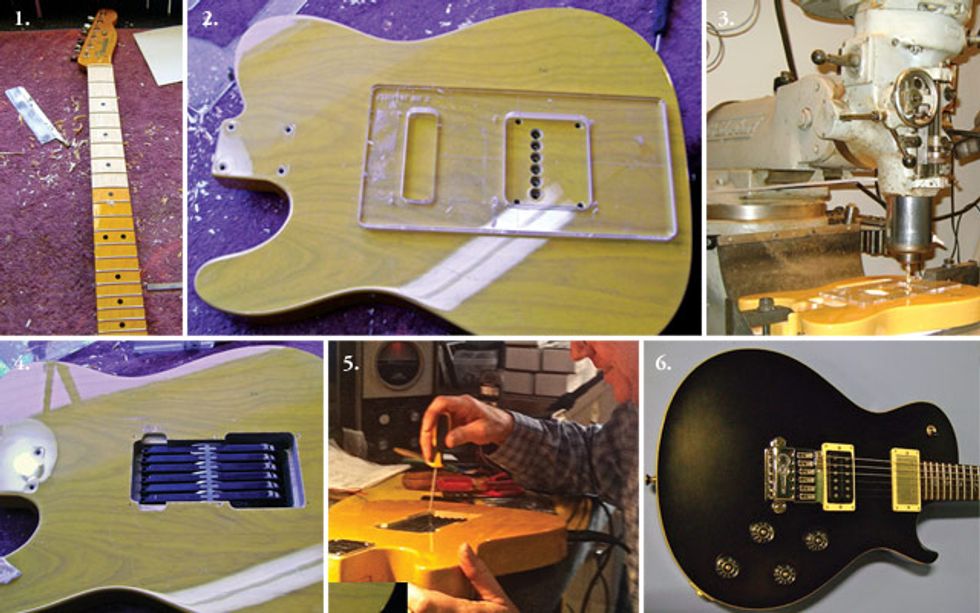1. Removing excess finish from a Tele’s fretboard for a snappier response. 2. Aligning the
routing template for the Evertune T model bridge. 3. Nick Drushel doing precision routing for
the Evertune. 4. Installing the Evertune hardware. 5. Tom Barkstrom putting the final touches
on the Evertune setup. 6. My PRS SC245 modded with an Evertune G model bridge and a
Mark Tremonti Treble bridge humbucker.
Most of us constantly search for ways to improve our tone and stay musically inspired. One way we can keep things fresh is to have an assortment of gear that collectively delivers a broad spectrum of diverse tones. Over the years, I’ve noticed that different guitars bring out different aspects of my playing. For instance, if a guitar has a thin sound and the notes decay quickly, that will often prompt me to play clean, “chanky” rhythm parts. Guitars have personalities and just like people, some personalities are better equipped to handle certain situations than others. When I determined that a couple of my guitars needed more defined personalities, I took them to Glaser Instruments in Nashville for an attitude adjustment.
The first guitar in line for mods was my Paul Reed Smith SC245. This has always been a great instrument for vintage tones, but I needed a guitar in my arsenal that would deliver more aggressive, modern-rock tones. The SC245’s single-cut mahogany body and maple top contributed some significant tonal characteristics for this sound, but the stock pickup in the bridge position wasn’t supplying the right vibe for my intentions. For modern rock, it's difficult to go wrong with a high-output, uncovered pickup, so I decided to have a PRS Mark Tremonti Treble humbucker installed in the bridge. This pickup has a broad scope of harmonic information and does a great job of teaming up with my high-gain amplifiers for a massive rock tone.
Next, I had the Glaser Instruments team install an Evertune G model bridge to ensure rock-solid tuning. The first thing people ask about when they see one of my guitars outfitted with an Evertune system is if the modification changes the sound of the guitar. If I were to compare the feel of my pre- and post-Evertune guitar to posture, I’d describe the guitar as feeling a bit more upright and robust after the installation. Perhaps surprisingly, the basic integrity of the tone was not compromised in the process. The Evertune simply adds a very slight amount of clarity to the sound of the strings.
The process of installing an Evertune bridge is very involved. A significant amount of wood has to be dug out of the body and everything has to line up just right. I pride myself on being a “do-it-yourselfer” in a lot of areas, but the Evertune installs on my PRS and Telecaster were jobs I left to the pros at Glaser Instruments.
Next up, I had to address an issue with my Telecaster’s fretboard. My goal with the Telecaster was to get the guitar as bright sounding as possible with plenty of bark, and the finish on the fretboard was getting in the way of this goal. Guitar necks will sometimes get sprayed with an excessive amount of finish. While some players like the way this feels, I prefer a faster-feeling fretboard without a bunch of sticky finish. Also, the applied finish can get caked onto the frets and dampen the springy feel and sound that notes should have on a maple fretboard. I know some of you might be thinking that fretboard finish has no affect on tone. But before you reject the idea, remember that reflection and absorption are factors in any sound, so it is vital to consider the materials that are interacting with the source of the sound.
When we clap our hands in a room full of carpets, the sound is short and dead. When we clap in a room with hard surfaces, the sound is longer, more complex, and alive. I’ve read that Brian Setzer actually takes a piece of wood on tour to put under his amps so the sound has something to “slap against.” I realize that finish and carpet are not the same density, but for the sake of illustration, too much finish on a fretboard has a “carpeted room-like” sound and takes some life out of the note. And I found that removing the finish from the fretboard added a considerable amount of liveliness to the tone and response from the guitar.
The modifications to the PRS and Tele significantly improved the tone and feel of each instrument. Because of this, I now use these instruments much more frequently. A good way to measure how much you like an instrument is simply determining how much time you spend playing it. If you have a guitar that spends most of its life in the case, take time to evaluate why it doesn’t inspire you to play it more often. Once you isolate the culprits, then you can begin to investigate an array of possibilities to give your instrument an attitude adjustment.














